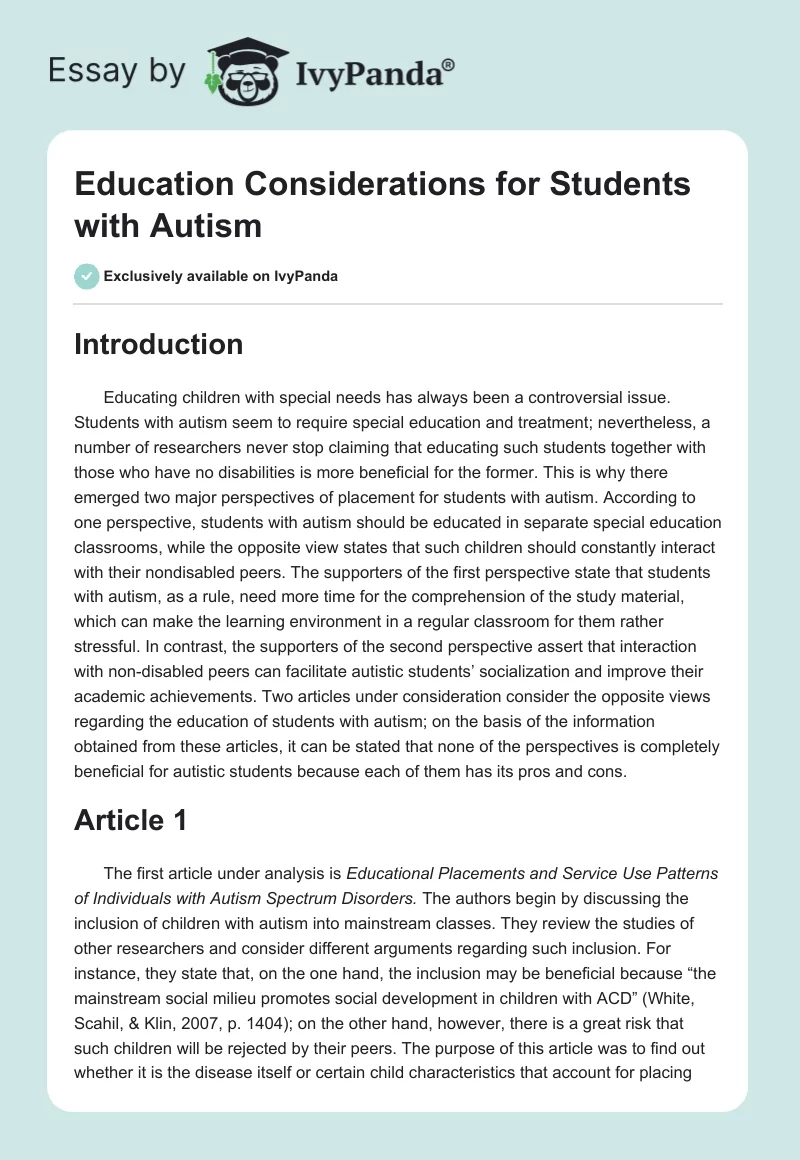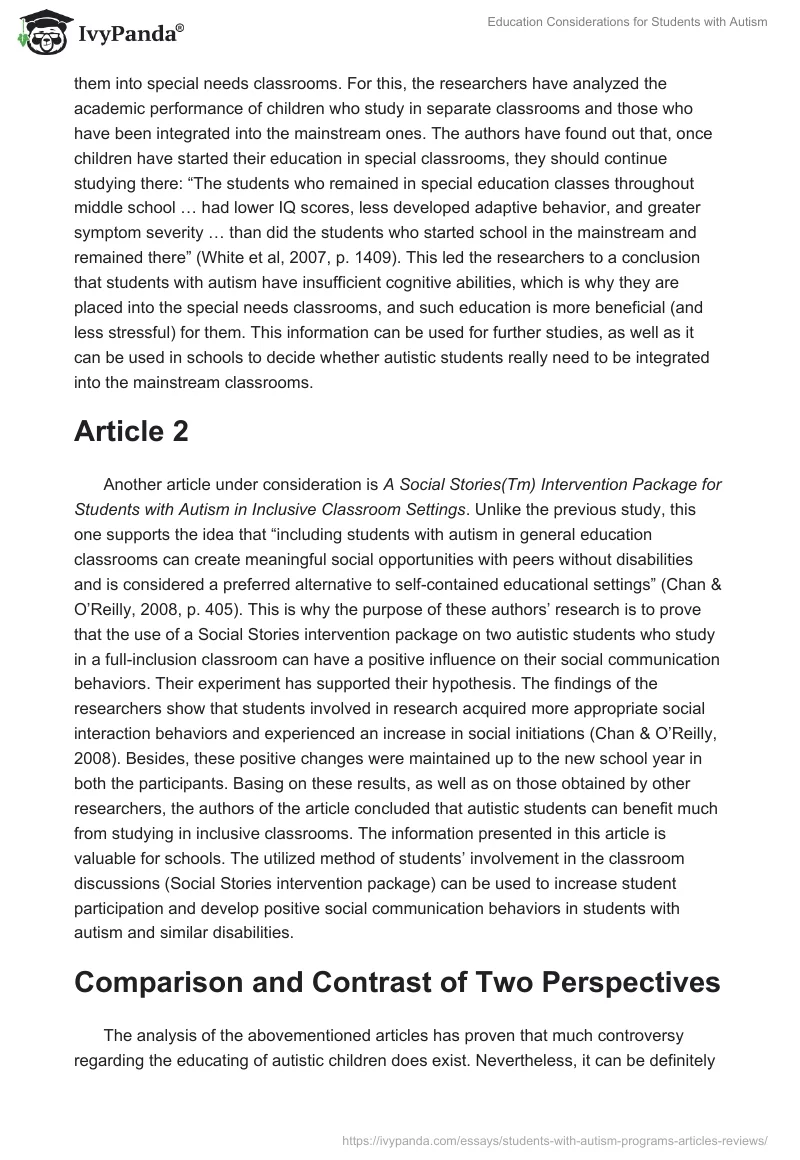Introduction
Educating children with special needs has always been a controversial issue. Students with autism seem to require special education and treatment; nevertheless, a number of researchers never stop claiming that educating such students together with those who have no disabilities is more beneficial for the former. This is why there emerged two major perspectives of placement for students with autism. According to one perspective, students with autism should be educated in separate special education classrooms, while the opposite view states that such children should constantly interact with their nondisabled peers. The supporters of the first perspective state that students with autism, as a rule, need more time for the comprehension of the study material, which can make the learning environment in a regular classroom for them rather stressful. In contrast, the supporters of the second perspective assert that interaction with non-disabled peers can facilitate autistic students’ socialization and improve their academic achievements. Two articles under consideration consider the opposite views regarding the education of students with autism; on the basis of the information obtained from these articles, it can be stated that none of the perspectives is completely beneficial for autistic students because each of them has its pros and cons.
Article 1
The first article under analysis is Educational Placements and Service Use Patterns of Individuals with Autism Spectrum Disorders. The authors begin by discussing the inclusion of children with autism into mainstream classes. They review the studies of other researchers and consider different arguments regarding such inclusion. For instance, they state that, on the one hand, the inclusion may be beneficial because “the mainstream social milieu promotes social development in children with ACD” (White, Scahil, & Klin, 2007, p. 1404); on the other hand, however, there is a great risk that such children will be rejected by their peers. The purpose of this article was to find out whether it is the disease itself or certain child characteristics that account for placing them into special needs classrooms. For this, the researchers have analyzed the academic performance of children who study in separate classrooms and those who have been integrated into the mainstream ones. The authors have found out that, once children have started their education in special classrooms, they should continue studying there: “The students who remained in special education classes throughout middle school … had lower IQ scores, less developed adaptive behavior, and greater symptom severity … than did the students who started school in the mainstream and remained there” (White et al, 2007, p. 1409). This led the researchers to a conclusion that students with autism have insufficient cognitive abilities, which is why they are placed into the special needs classrooms, and such education is more beneficial (and less stressful) for them. This information can be used for further studies, as well as it can be used in schools to decide whether autistic students really need to be integrated into the mainstream classrooms.
Article 2
Another article under consideration is A Social Stories(Tm) Intervention Package for Students with Autism in Inclusive Classroom Settings. Unlike the previous study, this one supports the idea that “including students with autism in general education classrooms can create meaningful social opportunities with peers without disabilities and is considered a preferred alternative to self-contained educational settings” (Chan & O’Reilly, 2008, p. 405). This is why the purpose of these authors’ research is to prove that the use of a Social Stories intervention package on two autistic students who study in a full-inclusion classroom can have a positive influence on their social communication behaviors. Their experiment has supported their hypothesis. The findings of the researchers show that students involved in research acquired more appropriate social interaction behaviors and experienced an increase in social initiations (Chan & O’Reilly, 2008). Besides, these positive changes were maintained up to the new school year in both the participants. Basing on these results, as well as on those obtained by other researchers, the authors of the article concluded that autistic students can benefit much from studying in inclusive classrooms. The information presented in this article is valuable for schools. The utilized method of students’ involvement in the classroom discussions (Social Stories intervention package) can be used to increase student participation and develop positive social communication behaviors in students with autism and similar disabilities.
Comparison and Contrast of Two Perspectives
The analysis of the abovementioned articles has proven that much controversy regarding the educating of autistic children does exist. Nevertheless, it can be definitely stated that each of the discussed perspectives has its pros and cons. For instance, the main advantage of the special separate classrooms is that children are under the observance of the instructors who were specially trained for working with autistic students. Besides, these children are in equal conditions, which means that they all are with disabilities and most of them need an additional explanation of the study material. At the same time, such students remain socially undeveloped because they communicate only with those who have disabilities, thus, being deprived of a chance to interact with non-disabled individuals and learn from their behaviors.
Similarly, the view that students with autism should be integrated into mainstream classrooms also has its advantages and disadvantages. For example, students with autism who study in inclusive classrooms have more possibilities to involve in cooperative learning and be exposed to external reinforcers. However, the greatest disadvantage of such inclusion is that they might be rejected by other students, as well as they can lag behind due to the lack of time to comprehend the study material.
So, parents and practitioners can have many concerns when placing autistic students into any of these educational environments. A practitioner, for example, may think of an additional psychological burden placed on a student with autism who studies in an inclusive class. Likewise, a parent will be concerned with the treatment of his/her child in such a classroom. At the same time, both understand that this placement is able to make the autistic child more prepared for future independence in the adult world, because, in the case with the education in special classrooms, the student will get used to communicating with non-disabled individuals and realize his/her difference from them.
Conclusion
Therefore, it is still impossible to decide which of these two opposing perspectives is more beneficial for students with autism. Being educated in special separate classrooms, autistic students get proper treatment and additional attention that they need, while studies in a general classroom help them to socialize. Each of these perspectives has serious disadvantages; studying in general classrooms may be difficult for autistic students physically and morally, while special needs classrooms provide them with no opportunities for social interaction. One thing that is definite is that inclusive classrooms make autistic students more independent, although it still remains unknown whether this independence will be helpful to them in the adult world because autistic people have incurable disabilities irrespective of the level of their social development.
Reference
Chan, J.M. & O-Reilly, M.F. (2008). A social stories ™ intervention package for students with autism in inclusive classroom settings. Journal of Applied Behavioral Analysis, 41(3), 405-409.
White, S.W., Scahill, L., & Klin, A. (2007). Educational Placements and Service Use Patterns of Individuals with Autism Spectrum Disorders. Journal of Autism and Developmental Disorders, 37(8), 1403-1413.


